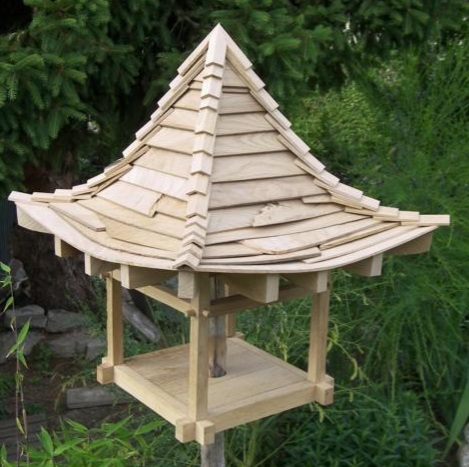What my Garden and Home objects are made of?
Each handmade wooden object is unique and made in accordance with the individual wishes of it’s future owner. This exclusivity is made possible by two factors. The first one is the structure of the object, that is, the composition and parts‘ interlocution: roofs, foundation, walls. All functions and shapes of objects are mutable. Moreover, the owner can decorate and modify the object by himself.
The second factor in exclusivity is materials combination. The number of potential mixes is infinite. So what am I make objects of? I work with natural wood that is durable and resistant to negative external factors. This means that the object can be installed both indoors and outdoors. Several types of wood are ideal.
Oak is a versatile material for interior and garden decor. This is a centuries-tested classic. Oak wood is renowned for it’s resistance to moisture and insects. The texture typical of oak is easily recognizable. This is a combination of loops and stripes on a longitudinal slice, prominent in mature trees. Oak products naturally get old nobly: wood turns deeper and more intense color. Artificial ageing by brushing is also possible.

Oak-Wood 
Oak – Object floor 
Oak – Wooden plank Surface
Bangkirai (balau) is an exotic type of tropical wood. Nowadays such material is cultivated on plantations to reduce the pressure on nature. So objects from it are unafraid of high humidity. Even deck boards are made from it, bathrooms and pools finishings. Bangkirai is also suitable for garden decor: feeders, bird houses, lighting systems. The wood is durable (1.5 times stronger than oak) and serves indefinitely. Bangkirai color palette — from pale yellow to deep brown-red. The texture of the material in longitudinal slices is picturesque due to the spiral arrangement of wood fibers.

Bangirai Handcrafted overlapping 
My workingbench 
Oak Foot for Objects
Pine is a democratic and affordable material. Pine is undemanding to living conditions, therefore it grows everywhere. The wood is quite light and soft. But the high resin content provides resistance to precipitation and parasites. The wood texture is repetative, explicit. The natural light yellow color of the wood, if desired, changes after processing with special compounds.
Walnut is a material with fine filaments, but strong and inelastic. It is easy to polish walnut. And it won’t crack. Therefore, the walnut is suitable for filigree and delicate parts. The color of walnut wood depends on the region of growth: the further north is darker. The pattern on the tree is prominent and varied, especially in the lower part of the trunk.
Wood is the main, but the only one material from which I make my objects. Otherwise it would be too boring) I decorate objects with metal parts: copper, brass, gold or silver foil. Laminated rice or Japanese paper, acrylic glass or fabrics are used for vertical structural elements. These can be windows or walls completely.
I like copper for it’s pleasant golden-pink color and plasticity. It is an eco-friendly material that blends with wood, glass, stone. Copper parts are used for 100 years or longer in the open air.
Brass is a sparkling copper-based alloy that looks like gold. And in terms of physical properties, brass is almost indistinguishable from gold. Depending on the composition, the brass alloy is greenish, muted yellow or reddish-golden color. Brass is almost corrosion-resistant. For the full protection the brass is varnished.
An object may be a real investment if it is made from exotic rare wood, decorated with gold or silver foil. Such foil maintains all merits of precious metals. An exclusive object would be the jewel of your garden or home interior. The object is marked with information about the date and place of creation, serial number, signature and name of the artist Markus Haydeck. An object created for the first time can cost more than its copies. But it is impossible to create several absolutely identical objects.
A popular material for wooden art objects, for example, lamps, lanterns, is Japanese paper (washi) made from vegetal or wood fibers. It is more durable and flexible than normal paper. Therefore, Japanese one is also used in traditional architecture, for making clothes, toys, fans and ritual objects.


Bangkirai Window with Laminated Paper 
Laminated rice paper is more accessible than washi. The protective cover will prevent mechanical damage, for example, by children or animals. Translucent paper contrasts favourable with dense and matte wood. Acrylic glass may be an alternative to paper. It is a lightweight polymer, translucent and durable. Externally acrylic glass is indistinguishable from ordinary glass, but without its main drawback — fragility.
Fans of sophisticated solutions will definitely appreciate the opportunity to decorate wooden art objects with fabric. Textile details with scenes from Japanese life, animalistic and floral prints are also selected individually. Light and sunlight come through paper, fabric or acrylic glass. So a candle, an electric lamp or even a miniature unpretentious plant may be placed inside wooden object. Any modern solutions are possible: an object plugged in to an outlet or powered by batteries might be an original lantern. It is completely safe and reliable.
But one rule is strictly followed. I create wooden objects in the same way as houses were built in Japan many centuries ago. Traditional joints of the wooden parts, proportions and aesthetics immerse in the atmosphere of those times. I subscribe to the Japanese outlook wabisabi. It is the aesthetics of imperfection, moderation, attention to detail and naturalness. Wabisabi is for those who are not chasing fleeting fashion. Wabisabi – elegant beauty that preserves the traces of time.
My art objects are scalable. Regardless of their size, they are carefully crafted according to tradition. It can be not only a garden decor or a lantern, but also a roomy tea pavilion or a reliable windscreen. Birds and pets love natural wood, so pet houses and feeders are also great solutions. All fantasies are realized as practical as possible.
















